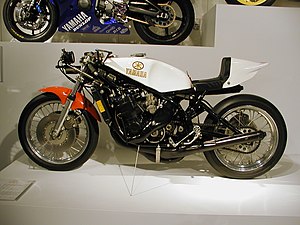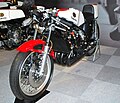Yamaha TZ 750
 Yamaha TZ 750 (1979) |
|
| Manufacturer | Yamaha engine |
| Production period | 1974 to 1979 |
| class | motorcycle |
| Motor data | |
| Two-stroke engine , water-cooled four-cylinder engine, inlet with diaphragm control | |
| Displacement (cm³) | 747 |
| Power (kW / PS ) | 88 (120) at 11,000 rpm (models D to F) |
| Top speed ( km / h) | 295 |
| drive | Chain |
| Brakes | front: double disc, rear: disc |
| Wheelbase (mm) | 1390-1407 |
| Empty weight (kg) | 152-157 |
The Yamaha TZ 750 was a commercially available racing motorcycle from the Japanese manufacturer Yamaha , which was used in the Formula 750 . From the 1974 season to the end of the formula with the 1979 season , the 567 copies of the Yamaha TZ 750 were the dominant racing motorcycle in this racing series. In addition, factory racing machines of this model were successful at Daytona 200 .
History and technology
The Formula 750, which was originally created for near-series motorcycles, was used by Yamaha to take part with production racers built in large numbers. For the first model, the TZ 700 (TZ 750 A) with a displacement of 694 cm³, the engine of the Yamaha TZ 350, which has been built for a year, was the inspiration. The A model achieved an output of 90 hp at 10,500 rpm, the TZ 750 B (1975), with an enlarged bore (from 64 to 66.4 mm) and thus 747 cm³ displacement, already 105 hp. Up to the last model, the TZ 750 F (1979) with 747 cm³ displacement (bore / stroke: 66.4 × 54 mm), the performance was steadily increased, until it was finally specified with over 120 hp.
The water-cooled in-line engine with contactless thyristor magneto ignition was supplied with an oil-fuel mixture (1:16) via four 34 mm Mikuni carburettors. The power was transmitted to the rear wheel via a six-speed gearbox with footshift (left) with the chain running open. The chassis consisted of a double-loop tubular frame with an oil-damped telescopic fork at the front and, from model D 1977, with a cantilever swing arm and an oil-dampened central spring strut at the rear (previously swing arm with two spring struts). The tire size was 3.25–18 at the front and 3.50–18 (3.75–18, from model D) at the rear. The TZ 750 had a hydraulically operated double disc brake in the front and a single disc brake in the rear. The fuel tank held 29 liters, the oil supply 1.5 liters.
The Yamaha TZ 750 ("The Beast") was the most powerful and fastest racing motorcycle on the market at the time. Like the heavily motorized motorcycles of the 1970s, it suffered from chassis problems, including high-speed commuting due to a lack of frame stability and too “thin” stanchions, which posed problems even for the top riders. Another cause was the diagonal racing tires at the time, which were not up to the performance requirement. The purchase price at that time (1977) was around 20,000 DM . Today, well-preserved specimens are traded between 42,000 and 53,000 euros .
Technical specifications
| TZ 750 A | TZ 750 B | TZ 750 C | TZ 750 D | TZ 750 E. | TZ 750 F | |
|---|---|---|---|---|---|---|
| Construction year | 1974 | 1975 | 1976 | 1977 | 1978 | 1979 |
| Displacement | 694 cc | 747 cc | 747 cc | 747 cc | 747 cc | 747 cc |
| Bore / stroke | 64 × 54 mm | 66.4 x 54 mm | 66.4 x 54 mm | 66.4 x 54 mm | 66.4 x 54 mm | 66.4 x 54 mm |
| Performance / at | 90 PS 10,500 min -1 |
105 PS 10,500 min -1 |
105 PS 10,500 min -1 |
120 PS 10,500 min -1 |
120 PS 11,000 min -1 |
120 PS 11,000 min -1 |
| wheelbase | 1407 mm | 1407 mm | 1407 mm | 1390 mm | 1390 mm | 1390 mm |
|
Steering head angle in degrees |
63 | 63 | 63 | 64 | 64 | 64 |
|
Trail in mm |
97 | 97 | 97 | |||
| Empty weight in kg | 157 | 157 | 157 | 152 | 152 | 152 |
| Quantities | 213 | 46 | 40 | 30th | 162 | 76 |
Factory machines
In order to obtain the homologation of the TZ 750 as a racing motorcycle for the Formula 750, the FIM initially planned a number of at least 200 vehicles, which was reduced to 25 at the end of 1974. With the proof of homologation, Yamaha also used special factory machines (Yamaha OW 31), which were essentially identical in construction, but technically ahead of the production racer and had more power. The factory machine from 1975 already had an output of 130 hp and the cantilever arm, and Kenny Roberts' and Steve Baker's factory racers from 1976 had 140 hp.
Others
Two coupled engines of the model A, each with 694 cm³ displacement, were used by Don Vesco as drive for his record vehicle "Silver Bird". On September 28, 1975, he set a new world speed record for motorcycles at 487.515 km / h .
literature
- Wolfgang Gruber: Formel 750. Motorbuch Verlag Stuttgart, 1st edition 1977, ISBN 3-87943-523-5 .
- Collin MacKellar: Yamaha. All Factory and Production Road-Racing Two-Strokes from 1955 to 1993 . The Crowood Press, 1st edition 1995, ISBN 978-18522-3920-6 .
Individual evidence
- ↑ Technical data TZ 750 A ( Memento from May 28, 2015 in the Internet Archive ) (accessed on May 27, 2015)
- ↑ a b c d Collin MacKellar: Yamaha . P. 188
- ↑ Siegfried Rauch: Famous Racing Motorcycles - 150 old and new racing machines for Grand Prix use . 2nd Edition. Motorbuch Verlag, Stuttgart 1980, ISBN 3-87943-590-1 , p. 260.
- ^ A b Axel Koenigsbeck, Hans J. Schneider, Peter Abelmann: Yamaha. Schneider Text Editions LTD., 1st edition 2004, ISBN 0-9541746-0-7 , p. 371.
- ↑ Mick Duckworth: Yamaha TZ 750 In: Great Engines In Bits. (accessed on June 4, 2015)
- ↑ Motorcycle catalog 1977 . Motor-Presse-Verlag, Stuttgart 1976, p. 193 u. 194.
- ↑ Radial tires were developed in the early 1980s.
- ↑ Non-slip at full performance only from 150 km / h. See Helmut Werner Bönsch: Introduction to motorcycle technology. 3. Edition. Motorbuch Verlag Stuttgart 1981, ISBN 3-87943-571-5 , p. 279.
- ↑ bonhams.com Lot 375 (accessed May 30, 2015)
- ↑ bonhams.com Lot 323 (accessed May 30, 2015)
- ↑ Wolfgang Gruber: Formula 750. P. 134.
- ↑ Collin Mackellar: Yamaha . P. 115.





